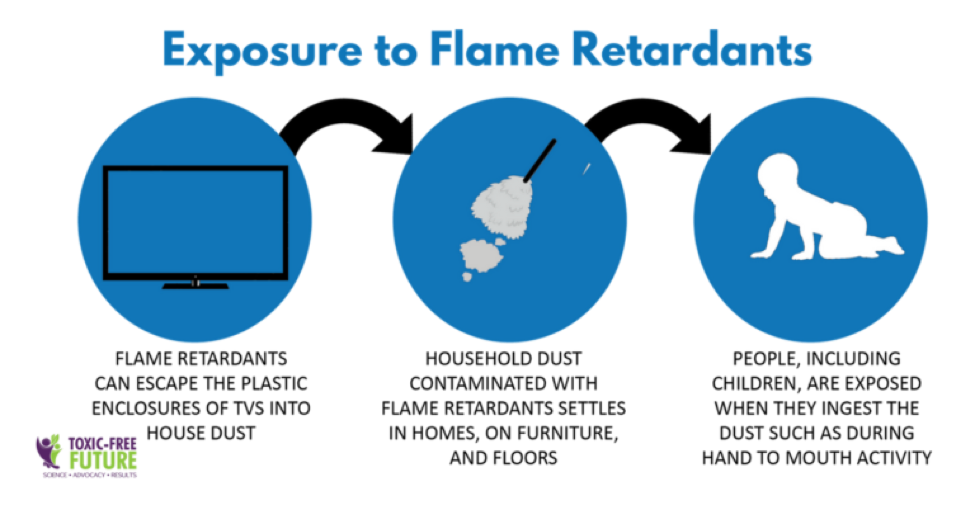Flame Retardants in TVs Need a Commercial Break
Watching your favorite shows doesn't have to involve harmful chemicals
Beth Kemler is the Mobilization Director for Safer Chemicals Healthy Families
The holiday season always feels like a great time to buy a TV- think of the Black Friday sales! Plus, watching holiday movies is always better in HD. But did you know that the plastic casings of many TVs on the market contain hazardous chemicals called organohalogen flame retardants. Of course, you don’t want your TV to catch fire during a binge-watching session, but there are better ways to protect ourselves rather than flame retardants.
What’s the problem with flame retardants?
While they may seem like a good idea, flame retardants actually do more harm than good. These chemicals have been linked to cancer, neurological disorders, impaired fertility, and developmental problems. They also don’t stay in your TV (or other products where they’re found)—they leach into the air and stick to household dust. Children and adults alike breathe them in, eat them when they touch surfaces coated with them and then handle food and even absorb them through their skin.
Studies have found them in the bodies of adults, children, and fetuses in the womb. They’ve even been found in breast milk and scientists suspect that the rise in flame retardants in our homes is linked to a rise in thyroid disease they’ve seen in indoor cats.
And when products containing flame retardant chemicals burn, the chemicals can make the smoke even more hazardous for firefighters. They can also be especially dangerous to workers and children who recycle the plastics from TVs and other electronics in facilities around the world. And these chemicals make it much harder to recycle the plastic—adding to our global plastic waste crisis. There’s basically nothing good about flame retardants.

Toxic TV Binge: hazardous flame retardant chemicals uncovered in Best Buy, Amazon TVs
Despite the hazards, it’s almost impossible to find a TV in the US that doesn’t contain flame retardants. A recent investigation by Safer Chemicals Healthy Families, where I work, and our partner organization Toxic-Free Future found flame retardants in every TV tested. Every single TV contained organohalogens, the worst class of flame retardants. One TV even contained deca-BDE, an organohalogen flame retardant that is banned in five states.
There are other ways manufacturers can reduce fire risk without relying on these harmful chemicals. Apple, for example, has replaced brominated flame retardants with safer alternatives and, in some cases, the company “eliminated [them] altogether through the use of naturally flame retardant materials such as aluminum.” Remember when your Macbook used to be made out of plastic? That’s a key reason they switched from plastic to aluminum — so they didn’t need toxic flame retardants.
Let manufacturers know you’re ready for a change!
Here’s the good news: electronics companies can replace these harmful chemicals with safer alternatives. Some companies are already using alternative chemicals or innovating to avoid these chemicals altogether. Some electronics brands, like Apple, have done this for computers, and TV brands can innovate too!
In fact, the European Union recently voted to ban these chemicals in TV plastic casings starting April 2021. If the European Union can do it, so can the US!
That’s why we started a petition to Best Buy, North America’s #1 electronics retailer. We’re asking the company to use its power to get toxic chemicals out of the TVs it sells. If European families will be getting TVs without these toxic chemicals, American families deserve the same. And Best Buy has the power to make it happen!
In the meantime, how can you reduce your family’s exposure?
Unfortunately, it’s nearly impossible to avoid all organohalgen flame retardants. Since manufacturers and retailers aren’t required to disclose their use of chemicals in most products, we can’t recommend any alternative TVs. But research has shown that you may be able to reduce your family’s exposure with frequent cleaning. Dust, vacuum and wash everyone’s hands often, especially before eating. Because flame retardants end up in household dust, reducing exposure to dust can help. Use a vacuum with a HEPA filter and regularly wet dust and wet mop.
The bottom line is that buying a TV shouldn’t pollute your home with toxic chemicals—or exacerbate the plastic waste crisis. If you agree, please sign the petition to Best Buy!
